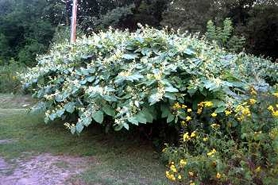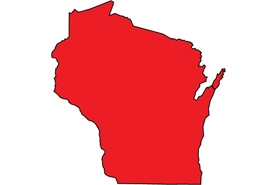Giant knotweed
(Fallopia sachalinensis or Polygonum sachalinense)
An herbaceous perennial that can reach up to 20’ tall with erect, hollow stems that resemble bamboo. Plants die back each year; the dried stalks remain standing into winter. Stems are smooth and arching with swollen nodes and twigs that zigzag from node to node.
Other names for this plant include:
- Common names: Sakhalin knotweed, Japanese bamboo
- Scientific names: Reynoutria sachalinensis
Classification in Wisconsin: Prohibited
- Ecological Threat
-
- Invades riparian areas where it prevents streamside tree regeneration.
- Increases soil erosion along streambanks.
- Often found in floodplain forests, disturbed areas, roadsides and vacant lots.
- Plants form dense stands that crowd and shade out native vegetation.
- Plants alter soil chemistry and may be allelopathic (exude chemical compounds toxic to native vegetation).
- Plant fragments as small as one inch have the potential to resprout.
- Japanese and giant knotweed are known to hybridize.
- Identification
-
Leaves: Alternate, simple, dark green. Leaves are 6-14” long and have a heart-shaped base coming narrow to a point. Immature rosette leaves often not lobed, resembling large violet leaves.
Flowers: Numerous small, greenish-white flowers appear in the leaf axils of the upper stems. Blooms are up to 4” long and occur during August-October. Giant knotweed blooms have both male and female parts in the same flower.
Fruits & seeds: Fruits are papery and broadly winged. Each fruit contains a 3-sided achene that is small, shiny and brown. Small amounts of seeds are viable and have no dormancy requirement.
Roots: Rhizomes that extend deeply into the soil creating a dense impenetrable mat.
Similar species: Japanese knotweed (P. cuspidatum) and Bohemian (hybrid) knotweed (P. cuspidatum x P. sachalinense) look very similar but can be distinguished by the type of hair on the veins on the undersides. Each species are equally as invasive. Japanese knotweed leaves are abruptly squared at the base and the flowers are dioecious. It has hollow stems with distinct raised nodes that give it the appearance of bamboo, though it is not related. Young plants are most commonly mistaken for rhubarb and referred to as donkey rhubarb.
- Control
-
Mechanical: Hand pull, mow or cut plants. Repeated cutting is needed to stimulate regrowth and exhaust root reserves. Digging plants is difficult because roots can extend deep into the soil. Discard plant debris cautiously as this plant aggressively reproduces vegetatively.
Chemical: Treat plants in the summer when there is a large amount of leaf surface to absorb and translocate systemic herbicides. Plants are more susceptible to herbicides if they are cut when 4-5’ tall and the regrowth treated is around 3’ tall. Foliar spray with 0.15% a.i. aminopyralid, 0.3 % a.i. Imazapyr, or either 2% a.i. glyphosate or triclopyr. Cut-stump treatment with 25% a.i. glyphosate or triclopyr.
- Resources
- Sources for content:
- Czarapata, Elizabeth; Invasive Plants of the Upper Midwest: an illustrated guide to their identification and control. The University of Wisconsin Press. 2005. Pg. 73-75
- Stone, Katharine R. 2010. Polygonum sachalinense, P. cuspidatum, P. × bohemicum. In: Fire Effects Information System, [Online]. U.S. Department of Agriculture, Forest Service, Rocky Mountain Research Station, Fire Sciences Laboratory (Producer). Available: http://www.fs.fed.us/database/feis/ [2013, Sept. 23].
- Invasive Plant Atlas of New England
- University of Wisconsin Extension - Weed Science


